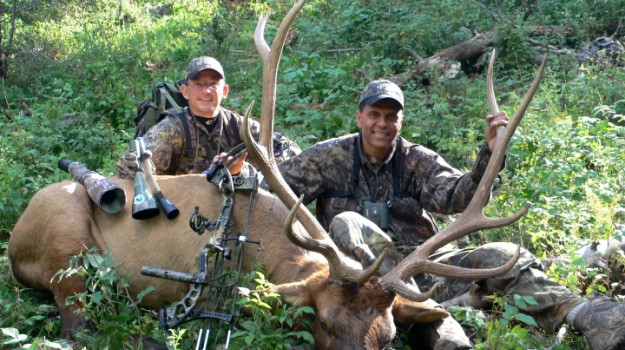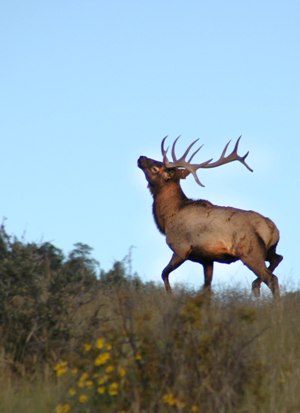
Editor’s Note: Ralph Ramos of Las Cruces, New Mexico, guides elk hunters in New Mexico, as well as teaches seminars on how to call elk. He’s been guiding elk hunters for more than 20 years, mainly in the Gila National Forest and the Lincoln National Forest. He’s been wearing Mossy Oak camouflage for 25 years, and his favorite pattern is Infinity. “This pattern has a lot of brown in it and blends in really well with the foliage and terrain where I hunt,” Ramos says. “I’ve been shooting PSE bows for 15 years. I’d been on several elk hunts with Pete Shepley the creator of PSE, and Pete introduced me to the people at Mossy Oak. Then I met Tim Anderson of Mossy Oak at one of the Rocky Mountain Elk Foundation (RMEF) national conventions in Reno, Nevada, when he attended my elk seminar. Since then, I’ve been an official Mossy Oak Pro. But I was wearing Mossy Oak long before I met Tim.
Herd bulls are always difficult to call, because they’re usually the biggest and the smartest bulls in an area. Most of the time, the only way you can call a herd bull in is by being persistent and staying after those bulls. Often, when the bull is at the top of the mountain, we’ll be at the bottom of the mountain. So, we climb the mountain. When we get to the top of the mountain, the bull may be at the bottom of the mountain. This up and down climbing for miles is what we have to do to have a chance to take one of these herd bulls. The whole time we’re chasing him, I’m cow calling. I want him to think that we’re two or three cow elk that have drifted away from his herd. Now, we’re trying to catch back up to him and the rest of the herd. Every now and then, as we’re chasing a bull like this, I’ll put in a little spike bugle call with my cow calling. However, as long as the bull is bugling, growling and grunting, or you can hear his cows calling, don’t call. When the bull becomes silent, this is when I start calling to him, so he’ll call back and give away his location.
 Once a bull finally arrives at the place where he’s going to bed down with his cows, he’ll generally start bugling to me. He’ll give full bore bugles with chuckles at the ends of these bugles. If he doesn’t hear any other bulls bugling back to him, he knows that bedding down with his harem is safe, and he and his girlfriends won’t be threatened by any other bulls. If the woods become silent after that bull bugles, and no other bulls bugle back to him. I’ll take my hunter and try to get within 150 yards of where the elk are bedded. I’ll start giving soft, quiet cow calls to get the bull to come to me to try and herd me back into his harem that’s bedded-down.
Once a bull finally arrives at the place where he’s going to bed down with his cows, he’ll generally start bugling to me. He’ll give full bore bugles with chuckles at the ends of these bugles. If he doesn’t hear any other bulls bugling back to him, he knows that bedding down with his harem is safe, and he and his girlfriends won’t be threatened by any other bulls. If the woods become silent after that bull bugles, and no other bulls bugle back to him. I’ll take my hunter and try to get within 150 yards of where the elk are bedded. I’ll start giving soft, quiet cow calls to get the bull to come to me to try and herd me back into his harem that’s bedded-down.
If he doesn’t come out to try and round me up, my next set of calls will simulate two bulls arguing back and forth. I’ll direct one of my bugles to my right. Using a different bugle, I’ll bugle, growl and chuckle to my left. I’ll pick up the tempo of these two bulls talking to each other. I’ll give the two bulls arguing type calling for about 10 minutes. If the bull still doesn’t come in, I take out an elk horn I always carry with me and start raking a tree with the elk horn. I’ll beat the ground like elk stomping, and I’ll add some bugles and growls while I’m rattling the elk horns. After I’ve worked the tree and the ground and bugled, I’ll start hitting the horns together really hard and rattling the horns loudly. When I get through with my rattling sequence, I’ll lay one horn on the ground and start beating that horn with the other horn. With my free hand, I’ll growl and half bugle through my bugle tube. Usually, this is when the herd bull will stand-up and start coming in toward me. While I’m going through that type of calling sequence, I don’t want to be more than 25-yards from my hunter, because the herd bull will come right to where he’s heard that fight. Once we go through all the steps I’ve just described, I’ve had bowhunters arrow elk at 10-15 yards.
Usually, in the middle of the day, most elk hunters will give up on a herd bull. They’ll eat lunch, take a nap or go back to the truck and rest before an afternoon hunt. But we don’t. We hunt all day long, especially if the bull’s calling and letting us know where he is.



























